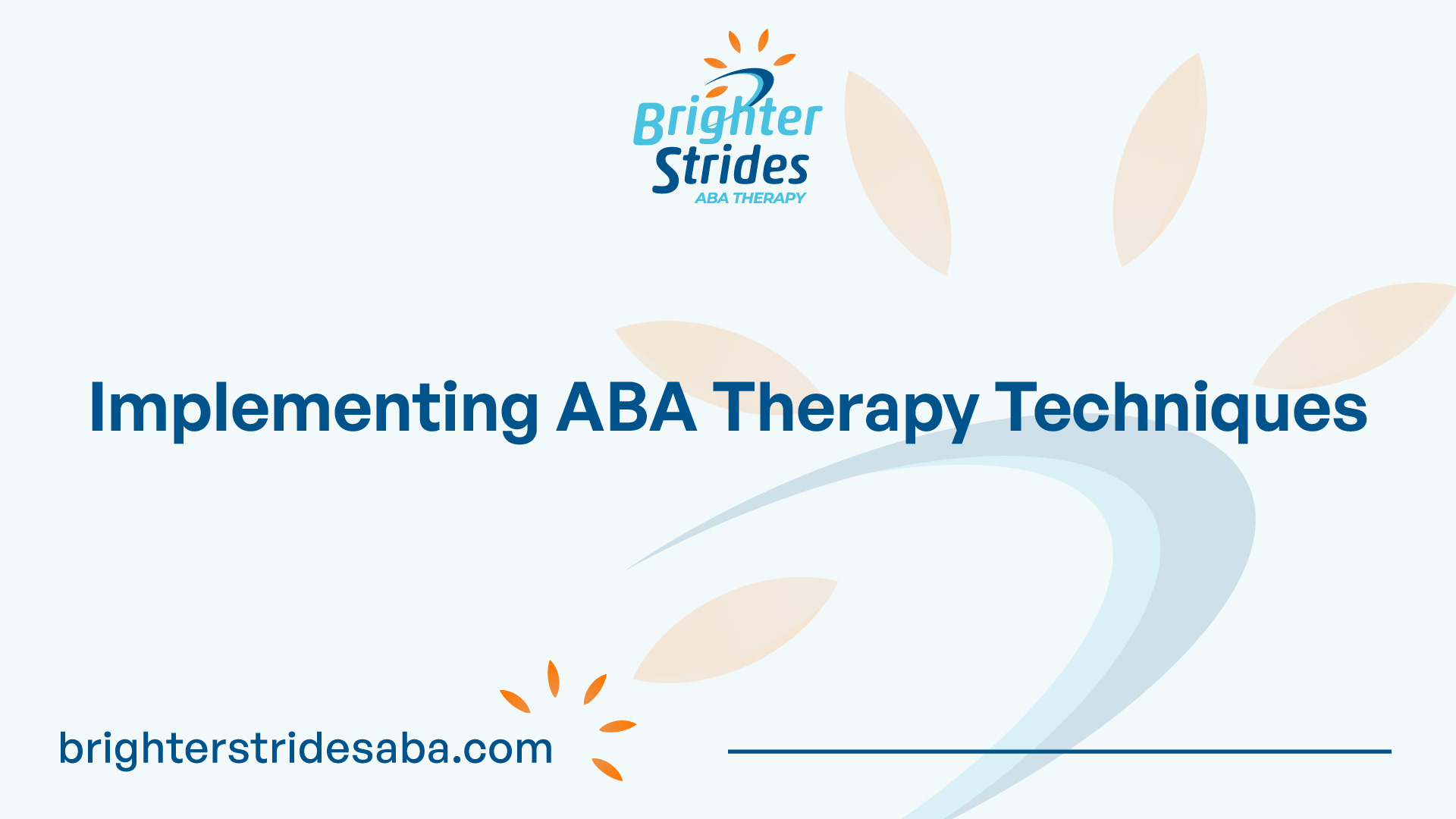
Understanding ABA Therapy Techniques
ABA therapy, or Applied Behavior Analysis therapy, is a scientifically-based intervention approach that focuses on improving behavior and enhancing daily living skills for individuals, particularly children, with autism. This section will explore the core principles of ABA therapy and the role of Board Certified Behavior Analysts (BCBAs) in implementing these techniques.
Core Principles of ABA Therapy
The foundation of ABA therapy is built upon several core principles that guide the therapeutic process. These principles are supported by scientific research and aim to bring about meaningful behavior changes in individuals with autism. Some of the key principles include:
- Generality: ABA therapy seeks to promote behavior changes that are applicable to various settings and situations, ensuring that the skills learned generalize beyond the therapy sessions.
- Effectiveness: The interventions used in ABA therapy are evidence-based and have been proven to be effective in improving targeted behaviors. The goal is to achieve meaningful and positive outcomes for individuals with autism.
- Technological: ABA therapy focuses on using clearly defined procedures and techniques that can be replicated by other professionals. This ensures that the therapy is systematic, transparent, and can be implemented consistently across different settings.
- Applied: The interventions used in ABA therapy are designed to address specific behaviors that have practical significance in an individual’s daily life. The goal is to bring about meaningful changes that improve the individual’s functioning and quality of life.
- Conceptually systematic: ABA therapy is grounded in the science of behavior analysis. It uses well-established principles and techniques to understand and modify behavior, ensuring that the interventions are based on a solid theoretical foundation.
- Analytic: ABA therapy relies on data collection and analysis to assess the effectiveness of interventions. Behavior analysts carefully track progress and make data-based decisions to modify treatment plans and ensure optimal outcomes for each individual [2].
- Behavioral: ABA therapy focuses on behavior as the target for intervention. It aims to replace challenging behaviors with more functional and appropriate behaviors through systematic and individualized strategies [3].
Role of Board Certified Behavior Analysts
Board Certified Behavior Analysts (BCBAs) play a vital role in the implementation of ABA therapy techniques. These highly trained professionals specialize in behavior analysis and are responsible for assessing, analyzing, and providing interventions for individuals with autism.
BCBAs design and oversee ABA programs, customizing them to meet the unique needs, abilities, and preferences of each individual. They collaborate closely with other professionals, such as therapists and educators, as well as the individual’s family, to ensure a comprehensive and integrated approach to intervention [3].
In addition to program design, BCBAs collect and analyze data to track progress and make data-driven decisions. This allows them to continuously evaluate the effectiveness of interventions, modify treatment plans as needed, and ensure that the individual is making meaningful progress toward their goals.
BCBAs also provide training and support to parents, family members, and caregivers, empowering them to implement ABA techniques and strategies outside of therapy sessions. This collaborative approach ensures consistency and generalization of skills across different environments and promotes the long-term success of the intervention.
By adhering to the core principles of ABA therapy and working closely with BCBAs, individuals with autism can benefit from effective and individualized interventions that promote positive behavior changes and improve their overall quality of life.

Implementing ABA Therapy Techniques
When it comes to implementing ABA therapy techniques, there are several effective strategies that can be utilized to support individuals in achieving their goals. In this section, we will explore three key techniques: positive and negative reinforcement, video modeling, and prompting and fading.
Positive and Negative Reinforcement
Positive reinforcement is a primary strategy used in ABA therapy, where individuals are more likely to repeat a behavior when it is followed by something they value or find rewarding. This can include praise, a toy, access to a preferred activity, or any other positive consequence. Positive reinforcement helps to strengthen desired behaviors and increase the likelihood of their occurrence again in the future. It is a powerful tool in shaping behavior and motivating individuals to learn and develop new skills. For a more detailed understanding of reinforcement methods in ABA therapy, refer to our article on ABA reinforcement methods.
On the other hand, negative reinforcement focuses on the removal or avoidance of an aversive stimulus to increase the occurrence of a desired behavior. It is important to note that negative reinforcement is not the same as punishment. Negative reinforcement is used to reinforce a behavior by removing something unpleasant or unwanted when the desired behavior occurs. This can be an effective technique in teaching individuals to engage in behaviors that allow them to escape or avoid unpleasant situations.
Video Modeling
Video modeling is a widely used ABA teaching tool that can be particularly beneficial for visual learners, including individuals with autism. This technique involves showing individuals videos that depict specific skills or behaviors they are expected to learn or imitate in real-life situations. By watching the video model, individuals can observe and learn the desired behavior, which can then be practiced and reinforced. Video modeling can be an effective way to teach a variety of skills, including social interactions, communication, and daily living tasks. For more information on video modeling and its applications, refer to our article on ABA skill acquisition.
Prompting and Fading
Prompting and fading is another valuable technique used in ABA therapy to teach new skills and promote independence. Prompting involves providing cues or hints to guide individuals in performing a specific behavior or completing a task. These prompts can be physical, verbal, or visual, depending on the individual’s needs and abilities. Prompting helps individuals acquire new skills by providing support and guidance.
Once individuals demonstrate competence in the desired behavior, prompting is gradually faded. Fading involves reducing the intensity or frequency of prompts over time, allowing individuals to gradually become more independent in performing the behavior. Fading is essential to promote generalization, as it helps individuals apply their learned skills in various settings and situations. By slowly reducing prompts, individuals can develop greater self-reliance and achieve long-term success. To learn more about tracking behavior and progress in ABA therapy, refer to our article on ABA behavior tracking.
By utilizing positive and negative reinforcement, video modeling, and prompting and fading techniques, ABA therapists can effectively support individuals in acquiring new skills and behaviors. These techniques, along with other strategies and interventions, are tailored to meet the unique needs and goals of each individual. The use of evidence-based ABA techniques helps individuals with autism and other developmental disabilities reach their full potential and lead more independent and fulfilling lives.
Effective Strategies in ABA Therapy
When it comes to implementing effective strategies in ABA therapy, several techniques have proven to be highly beneficial. In this section, we will explore three key strategies: natural environment teaching, behavior contracts, and discrete trial training (DTT).
Natural Environment Teaching
Natural environment teaching (NET) is a technique used in ABA therapy that encourages children to learn in real-life settings, such as the grocery store or playground. By incorporating natural environments into therapy sessions, children with autism can generalize their skills across different contexts. This approach helps to bridge the gap between therapy sessions and real-world situations, promoting meaningful learning experiences [4].
During NET, therapists create opportunities for learning within the child’s natural environment, capitalizing on their interests and preferences. This technique allows for the practice of various skills, such as social interactions, communication, and adaptive behaviors, in a more authentic setting. By engaging children in meaningful activities, NET enhances their motivation and promotes the generalization of skills beyond the therapy room.
Behavior Contracts
Behavior contracts are particularly effective for slightly older children with autism who have a good understanding of positive and negative reinforcement. These contracts outline specific tasks or behaviors that the child is expected to accomplish. By clearly defining the desired behaviors and their corresponding rewards, behavior contracts provide structure and motivation for children to achieve their goals.
The contract typically includes a set of expectations, rewards, and consequences. For example, the child may earn gold tokens for completing tasks or displaying appropriate behaviors. These tokens can be exchanged for desired rewards, such as extra free time or a preferred activity. By utilizing behavior contracts, children with autism are encouraged to take ownership of their actions and understand the consequences of their behavior [4].
Discrete Trial Training (DTT)
Discrete Trial Training (DTT) is a widely used teaching strategy in ABA therapy. This technique involves breaking down complex skills into smaller, more manageable components. Each component is then taught in a structured and systematic manner, utilizing repetitive trials and positive reinforcement for correct responses.
For example, when teaching emotions, DTT would involve breaking down different emotions into individual lessons. The child would be presented with a stimulus, such as a picture or facial expression, and prompted to identify the corresponding emotion. Correct responses are reinforced with rewards, such as praise, tokens, or small treats. DTT allows for focused teaching, making it easier for children with autism to acquire new skills [5].
By utilizing natural environment teaching, behavior contracts, and discrete trial training, ABA therapists can help children with autism develop essential skills in various areas. These strategies, tailored to the individual needs of each child, play a crucial role in promoting growth, independence, and overall progress in ABA therapy.

Specialized Techniques in ABA Therapy
ABA therapy utilizes a range of specialized techniques to address the unique needs of individuals receiving treatment. These techniques are designed to promote positive behavior change and support skill development. In this section, we will explore three important techniques used in ABA therapy: Antecedent-based Interventions (ABI), Functional Behavior Assessment (FBA), and Parent-implemented Intervention (PII).
Antecedent-based Interventions (ABI)
Antecedent-based Interventions (ABI) in ABA therapy focus on modifying the environment to reduce interfering behaviors triggered by antecedents. By altering the environment, therapists can effectively minimize the occurrence of problematic behaviors and set the stage for success. Strategies may include creating environments with fewer distractions or providing visual cues to help the child focus on intended antecedents. These modifications help individuals with autism spectrum disorder (ASD) better engage in desired behaviors and learn new skills.
Functional Behavior Assessment (FBA)
Functional Behavior Assessment (FBA) is a crucial tool used by ABA therapists to identify specific behaviors that require alteration and determine the underlying factors that maintain those behaviors. Through careful observation and data collection, behavior analysts can gain insights into the function or purpose of the behavior. This understanding allows them to design effective interventions tailored to the individual’s needs. By addressing the underlying causes of challenging behaviors, FBA forms the basis for creating behavior intervention plans that support the child’s learning and growth [5].
Parent-implemented Intervention (PII)
Parent-implemented Intervention (PII) is a collaborative approach that involves training and empowering parents to provide interventions for their child in natural settings. This technique has proven to be highly effective, particularly for children on the autism spectrum. By involving parents in therapy sessions and equipping them with the necessary skills, children can receive consistent support and intervention within their home environment. PII reduces delays in receiving appropriate care and ensures that children have opportunities to learn and practice skills in everyday situations.
These specialized techniques, along with other evidence-based strategies, form the foundation of ABA therapy. By utilizing antecedent-based interventions, conducting functional behavior assessments, and involving parents in the intervention process, ABA therapists can create individualized treatment plans that address the specific needs of each child. The goal is to enhance social, communication, and self-help behaviors, enabling individuals with autism to thrive and reach their full potential.
Impact of ABA Therapy
ABA therapy, with its focus on behavior modification, has a significant impact on individuals receiving this treatment. Let’s explore some of the key areas where ABA therapy has proven beneficial: early intervention benefits, individualized treatment plans, and environment modification.
Early Intervention Benefits
Starting ABA therapy as early as possible is crucial for achieving the best outcomes. Research suggests that beginning ABA therapy before the age of four can significantly enhance children’s development, improving their social and communication skills. Early intervention allows for targeted interventions to address challenging behaviors, helping children acquire and develop essential skills crucial for their overall growth and future success.
By targeting specific behaviors and providing intensive therapy, ABA therapy helps individuals with autism and related developmental disorders achieve their full potential. Early intervention through ABA therapy can positively impact a child’s cognitive, social, and emotional development, setting them up for a more independent and fulfilling life.
Individualized Treatment Plans
One of the strengths of ABA therapy lies in its individualized approach. ABA therapists work closely with individuals and their families to create personalized treatment plans tailored to their unique needs and goals. These plans take into account the specific behaviors that need to be addressed and the skills that need to be acquired.
Individualized treatment plans in ABA therapy involve conducting comprehensive assessments, such as functional behavior assessments, to understand the underlying causes of challenging behaviors. Based on these assessments, specific goals and targets are established to guide the therapy process.
ABA therapists utilize various techniques, such as reinforcement methods, skill acquisition, and behavior tracking, to systematically address challenging behaviors and teach new skills. The individualized nature of ABA therapy ensures that the treatment is tailored to the unique needs and strengths of each individual, maximizing their progress and success.
Environment Modification
ABA therapy recognizes the importance of the environment in shaping behavior. Therapists work with individuals and their families to modify the environment to support positive behavioral changes. This may involve making changes to the physical environment, establishing structured routines, and implementing behavior contracts [5].
By modifying the environment, individuals are given opportunities to practice and generalize newly learned skills in various settings. This helps ensure that the skills acquired during therapy are applicable and transferable to real-life situations.
Moreover, ABA therapy often involves collaboration with parents and caregivers to provide consistent reinforcement and support at home and in other environments. This collaborative approach ensures that the principles and techniques learned during therapy are reinforced consistently, leading to more effective and lasting behavior change.
The impact of ABA therapy extends beyond the treatment period, as the skills learned and behaviors modified through therapy can have a lasting and positive influence on an individual’s life. By focusing on early intervention, individualized treatment plans, and environment modification, ABA therapy empowers individuals to achieve their full potential and lead more fulfilling lives.
Research Insights on ABA Therapy
As a scientifically backed approach, ABA therapy has been the subject of extensive research to evaluate its efficacy and long-term effects. Understanding the research insights can provide valuable information about the impact of ABA-based interventions and their comparative analysis with other treatment approaches.
Efficacy of ABA-Based Interventions
Research consistently supports the efficacy of ABA-based interventions for individuals with autism spectrum disorder (ASD). ABA therapy helps individuals with autism learn and develop essential skills to improve and manage their behaviors, ultimately enhancing their overall quality of life. Studies have shown that ABA therapy is particularly effective as an early intervention approach for children with autism, allowing them to acquire skills they will use for the rest of their lives.
The seven core concepts, known as the seven dimensions of ABA, provide a foundation for the effectiveness of ABA therapy. These dimensions ensure that treatment is based on meaningful research and individualized to address specific needs. By emphasizing generalization, effectiveness, technological aspects, application of learned skills, systematic conceptualization, analytics, and addressing behaviors, ABA therapy aims to provide evidence-based and data-driven interventions [6].
Long-Term Effects of ABA Therapy
Long-term, comprehensive ABA-based interventions have shown significant benefits for the lifelong development of individuals with ASD. Research indicates positive effects on intellectual functioning, language development, acquisition of daily living skills, and social functioning. ABA therapy equips individuals with the necessary tools to navigate various settings, including home, school, and public environments like grocery stores or parks. By focusing on communication, social interaction, daily living skills, and managing challenging behaviors, ABA therapy empowers individuals with autism to thrive and reach their full potential.
Comparative Analysis of Interventions
Comparative analysis of interventions for individuals with autism has consistently shown the effectiveness of ABA therapy. Compared to other treatment approaches, ABA-based interventions have demonstrated superior outcomes in terms of skill acquisition, behavior management, and overall progress. The evidence-based techniques, positive reinforcement, and systematic approach of ABA therapy contribute to its effectiveness in helping individuals with autism learn, develop, and function optimally in various aspects of life.
By staying up-to-date with research insights on ABA therapy, individuals, families, and professionals can make informed decisions about the most effective interventions for individuals with autism. ABA therapy’s evidence-based approach, focus on skill acquisition, and long-term positive effects make it a highly regarded and widely utilized treatment option for individuals on the autism spectrum.
References
- https://www.autismparentingmagazine.com/aba-principles/
- https://wellspringlearningcenters.com/the-principles-of-aba/
- https://www.autismspeaks.org/applied-behavior-analysis
- https://dreambigchildren.com/understanding-aba-techniques-7-strategies-you-need-to-know/
- https://hiddentalentsaba.com/aba-therapy-techniques/
- https://behavioral-innovations.com/autism-101/what-is-aba/
- https://www.ncbi.nlm.nih.gov/pmc/articles/PMC7265021/

 We've just released an article!
Check out our blog!
We've just released an article!
Check out our blog!



